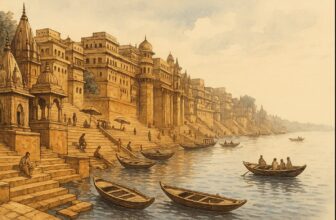India is full of iconic public spaces places like Marine Drive, Lodhi Gardens, or India Gate are well-known and widely celebrated. But beyond these popular landmarks lie several underappreciated public areas across the country, designed with purpose, sustainability, and people in mind. These parks, promenades, lakefronts, and community spaces reflect smart planning and cultural sensitivity, yet they often don’t get the national attention they deserve.
This list highlights 13 beautifully designed Indian public spaces that are quietly transforming their cities and deserve to be in the spotlight.
1. Sabarmati Riverfront, Ahmedabad (Gujarat)
A landmark in urban riverfront development, the Sabarmati Riverfront transformed a once-neglected stretch into a clean, accessible, and multifunctional public space. It features promenades, landscaped parks, cycling tracks, and cultural zones, all while managing stormwater and urban runoff. Its integration with the city’s life and infrastructure makes it a model for other urban centers.
2. Rock Garden, Chandigarh (Punjab & Haryana)
Created by artist Nek Chand using recycled materials, the Rock Garden is an imaginative public space that redefines what a park can be. Sculptures made from broken ceramics, glass, and industrial waste line its winding paths. More than an art installation, it’s a people-friendly space that celebrates creativity and reuse.
3. Janeshwar Mishra Park, Lucknow (Uttar Pradesh)
Spanning over 370 acres, this park in Gomti Nagar is one of Asia’s largest eco-friendly public spaces. It includes dedicated zones for cycling, jogging, picnics, meditation, and boating, with an artificial lake at its heart. Solar lighting, underground irrigation, and urban biodiversity make it both modern and environmentally responsible.
4. Eco Park, New Town, Kolkata (West Bengal)
This 480-acre park in Kolkata’s New Town blends recreation with ecological awareness. It features themed gardens, wetlands, bamboo groves, and a large lake with boating and cycling paths. The layout is thoughtfully zoned for leisure, fitness, and nature learning—yet it remains one of India’s most underrated urban parks.
5. Lalbagh Botanical Garden, Bengaluru (Karnataka)
Though not unknown, Lalbagh often plays second fiddle to Cubbon Park. Its design, however, is far more formal and historic. With origins in the 18th century and additions by British horticulturists, it features a rare glasshouse, lake, and over 1,800 species of plants. Its blend of classical landscape design and biodiversity deserves greater national recognition.
6. Sukhna Lake Promenade, Chandigarh
A core part of Le Corbusier’s Chandigarh vision, Sukhna Lake is more than a water body. Its wide, accessible promenade is lined with trees, shaded seating, and activity zones. It’s used by walkers, artists, families, and fitness groups daily—a serene example of public design that supports civic life.
7. Kankaria Lakefront, Ahmedabad (Gujarat)
Revamped from a historical lake into a multifunctional civic space, Kankaria Lake now features a toy train, food courts, open-air theatre, zoo, and tethered balloon rides. It blends heritage preservation with modern urban leisure and attracts people across age groups without being exclusive.
8. Central Vista Park, Raipur (Chhattisgarh)
A modern example of civic park planning, this central green space offers amphitheatres, ornamental gardens, civic art, and walking trails in a city that is still developing its urban identity. It’s clean, safe, and family-friendly—yet rarely featured in national discussions on good public design.
9. Napier Museum Park, Thiruvananthapuram (Kerala)
Surrounding the iconic Napier Museum, this public space blends open green lawns, tree-lined pathways, and shaded seating. It’s a favorite of locals, offering a calm environment in the city’s cultural district. Its subtle design draws from Kerala’s landscape sensibilities, without overt architecture.
10. Yamuna Biodiversity Park, Delhi
Amid the traffic and concrete of Delhi, this park offers a rare example of ecological restoration. Spread across former wasteland, it now supports native flora and fauna, with wetlands, forests, and walking trails. Designed for both conservation and public use, it’s a learning ground as much as a recreational space.
11. Rani-ki-Vav Garden Zone, Patan (Gujarat)
While the stepwell itself is UNESCO-listed, the surrounding landscape has been developed into a public interpretation zone. With quiet walkways, manicured gardens, and historical signage, it allows visitors to experience the heritage site slowly and respectfully—a rare example of thoughtful heritage integration into a usable public space.
12. Dr. APJ Abdul Kalam Memorial, Rameswaram (Tamil Nadu)
More than just a monument, this memorial includes a well-designed public forecourt, landscaped gardens, and pathways that invite quiet reflection. Built using regional architectural styles, it serves both as a tribute and a meaningful civic space.
13. Shanti Stupa Plaza, Leh (Ladakh)
Set atop a hill, the Shanti Stupa is not only a spiritual symbol but a uniquely designed public space. Its terraced layout, clean stone plazas, and open panoramic views create a place for gathering, meditation, and peaceful interaction with the landscape. Its minimalism makes it timeless.
Conclusion – Indian Public Spaces That Mix Sustainability with Beauty
Public spaces shape the way cities feel and function. The 13 places listed here prove that great design doesn’t need to shout—it just needs to serve people thoughtfully. Whether through ecological restoration, community access, or cultural integration, these spaces are examples of what urban India can do when design meets purpose. They may not be trending on social media, but they’re enriching lives every day—and that’s worth attention.





